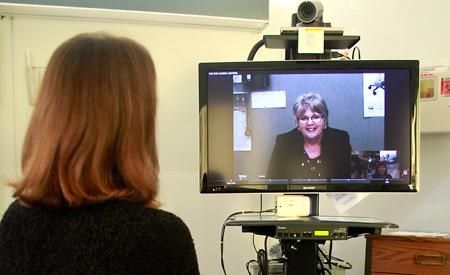A new program at Powell River General Hospital (PRGH) is making it easier for patients to access specialized medicine from outside the community and may play a significant role in diagnosing stroke patients earlier.
Powell River General Hospital Foundation has committed $40,000 to funding a telehealth program, a system that uses video-conferencing technology to help patients and doctors consult with specialists who may reside outside of the community or even outside the province.
The hospital will have three telehealth terminals: one mobile unit in the emergency room, one for patients to have private consultations and one in a meeting room.
The technology is not unlike current voice-over-Internet-protocol applications like Skype, but uses high resolution cameras and travels over a secure health network. The system gives the doctor control over the patient’s camera to help in examinations.
“If you think about the specialists in Powell River,” said Lu Wuthrich, manager of acute services at PRGH, “we don’t have a pediatrician or a lot of other clinicians, but we have connections to them.”
She added that a lot of patients who have suffered hip fractures have to go to Vancouver Island for treatment and then have to return at a later date for the doctor to check the patient’s progress, but often the check up is simply the doctor asking questions.
“You don’t need to go to the island to do that,” she said. She calls the technology, “the future of medicine for rural communities,” for patients who need to consult with specialists.
“We’re not saying that we can do everything with telehealth, but we can do a good portion of it,” said Brian Bootsman. Bootsman specializes in information technology services for Provincial Health Services Authority which coordinates between the five provincial health authorities. “And if we take a good portion of those appointments and make it so they don’t have to travel across to the island or Vancouver, the savings on gas and on time and lost salary is huge.”
There are currently over 290 telehealth sites throughout the province and over 600 videoconferencing terminals.
The actual equipment comes in different forms depending on what the application will be. Fixed units can be set up in meeting rooms for patients and doctors to hold consultations and mobile units are set up to be used for emergency room applications for helping treat trauma and strokes. Peripheral devices can be added on to share ultrasound and regular images, vital signs and body sounds.
A new telepharmacy initiative between Lions Gate Hospital and PRGH will help to address the need for more pharmacists in Powell River.
While the telehealth program has existed around the province for the last 15 years, the newer telestroke program has increased usefulness of telehealth by helping neurologists diagnose strokes.
“We’re coming up to date with the rest of the province but the novel application of the telestroke is a kind of step ahead,” said Dal Matterson, president of the hospital foundation.
Because timeliness is an important factor in treating patients who are having a stroke, the technology with its peripheral high-resolution camera allows neurologists to take a close look at a patient’s pupils to increase the certainty of their stroke diagnosis.
“The key is if you can catch them in that critical window then that clot-busting drug really does become quite a benefit for these patients,” said Liz Santos, clinical telehealth coordinator for Vancouver Coastal Health.
Currently, Vancouver Coastal Health has telestroke connections between Vancouver General Hospital, Peace Arch Hospital in Surrey and Chilliwack Hospital.



